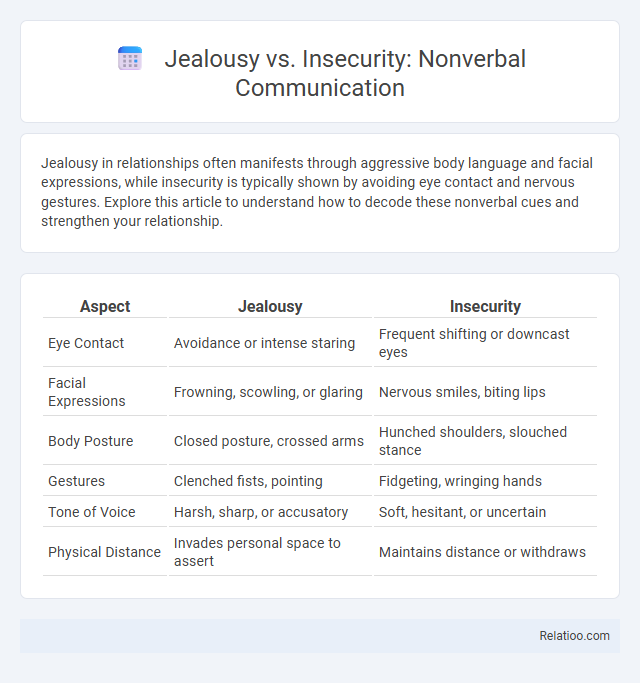Jealousy in relationships often manifests through aggressive body language and facial expressions, while insecurity is typically shown by avoiding eye contact and nervous gestures. Explore this article to understand how to decode these nonverbal cues and strengthen your relationship.
Table of Comparison
| Aspect | Jealousy | Insecurity |
|---|---|---|
| Eye Contact | Avoidance or intense staring | Frequent shifting or downcast eyes |
| Facial Expressions | Frowning, scowling, or glaring | Nervous smiles, biting lips |
| Body Posture | Closed posture, crossed arms | Hunched shoulders, slouched stance |
| Gestures | Clenched fists, pointing | Fidgeting, wringing hands |
| Tone of Voice | Harsh, sharp, or accusatory | Soft, hesitant, or uncertain |
| Physical Distance | Invades personal space to assert | Maintains distance or withdraws |
Understanding Jealousy and Insecurity: Key Differences
Jealousy often manifests through nonverbal cues such as narrowed eyes, crossed arms, and subtle frowns, indicating possessiveness or fear of loss, while insecurity typically shows through nervous behaviors like avoiding eye contact, fidgeting, and closed body language, reflecting self-doubt or vulnerability. Recognizing these distinct nonverbal communication patterns helps in accurately interpreting emotional states and addressing underlying relational issues. Understanding the key differences between jealousy and insecurity enhances interpersonal awareness and promotes healthier emotional responses.
The Science Behind Nonverbal Communication
Jealousy and insecurity manifest differently through nonverbal cues, with jealousy often triggering more intense facial expressions like narrowed eyes or clenched jaws, while insecurity might show through avoidant gaze and fidgeting. The science behind nonverbal communication reveals that these subtle signals are processed unconsciously, influencing how others perceive and respond to your emotional state. Understanding these distinctions helps you interpret and manage social interactions more effectively.
Common Nonverbal Signs of Jealousy
Common nonverbal signs of jealousy include clenched fists, tense facial expressions, and prolonged gaze fixation, which reveal underlying emotional discomfort. You might also notice subtle body language cues like crossed arms or avoidance of eye contact signaling insecurity intertwined with jealousy. Recognizing these nonverbal communications helps interpret complex emotional states more accurately in social interactions.
Nonverbal Cues Associated with Insecurity
Nonverbal cues associated with insecurity often include avoiding eye contact, fidgeting, and closed body language such as crossed arms or hunched shoulders. These behaviors signal discomfort and self-doubt, distinguishing them from jealousy, which may involve more confrontational or outwardly expressive gestures like glaring or tense facial expressions. Recognizing these subtle nonverbal indicators helps in accurately identifying insecurity in interpersonal communication.
Body Language: Jealousy vs. Insecurity
Jealousy in body language often manifests as crossed arms, narrowed eyes, and invasive glances, signaling possessiveness and alertness to threats. Insecurity displays through fidgeting, avoiding eye contact, and closed postures, reflecting self-doubt and vulnerability. Understanding these distinct nonverbal cues helps you decode emotional states accurately, improving interpersonal communication and emotional intelligence.
Facial Expressions: Decoding Hidden Emotions
Facial expressions reveal key differences between jealousy and insecurity through subtle nonverbal cues such as tightened lips or furrowed brows that signal jealousy, while insecurity often manifests as averting gaze or hesitant smiles. You can better understand hidden emotions by closely observing microexpressions, which provide insights beyond verbal communication. Decoding these facial expressions enhances emotional intelligence and interpersonal awareness in social interactions.
Tone of Voice and Speech Patterns in Emotional Expression
Jealousy and insecurity often manifest through distinct nonverbal cues, particularly in tone of voice and speech patterns; jealousy may involve sharper, more abrupt tones reflecting possessiveness, while insecurity typically features hesitant or lower-volume speech indicating self-doubt. Your awareness of these subtle vocal variations can enhance emotional understanding and interpersonal communication. Recognizing these patterns enables you to better interpret underlying emotions beyond spoken words.
Context Matters: Situational Triggers for Jealousy and Insecurity
Jealousy and insecurity manifest through distinct nonverbal cues influenced heavily by context and situational triggers, such as social interactions or perceived threats to relationships. Your awareness of subtle gestures like avoiding eye contact, tense posture, or clenched fists can reveal underlying feelings of jealousy or insecurity before verbal expression occurs. Understanding these contextual nonverbal signals helps in accurately interpreting emotional states and addressing interpersonal issues effectively.
How to Respond to Nonverbal Signs of Emotional Struggle
Nonverbal communication of jealousy often includes crossed arms, narrowed eyes, and tense posture, signaling discomfort and guardedness, while insecurity may manifest through avoiding eye contact, fidgeting, and withdrawn gestures, indicating vulnerability. To respond effectively to these nonverbal cues, maintain an open, empathetic stance with relaxed body language to encourage trust and dialogue. Offering supportive gestures such as nodding and gentle eye contact helps validate their feelings and fosters a safe environment for emotional expression.
Strategies for Improving Emotional Awareness and Communication
Jealousy often triggers heightened nonverbal cues such as tense postures and avoidant eye contact, while insecurity may manifest through fidgeting or closed body language. Strategies for improving emotional awareness involve mindful observation of these nonverbal signals combined with self-reflection to identify underlying feelings. Enhancing communication entails empathetic listening and expressive clarity to effectively convey and address emotions without escalating misunderstandings.

Infographic: Jealousy vs Insecurity nonverbal communication
 relatioo.com
relatioo.com